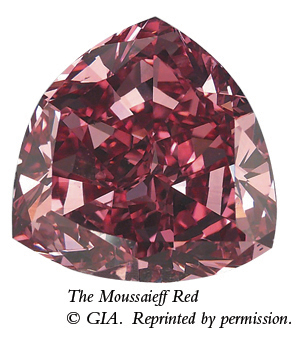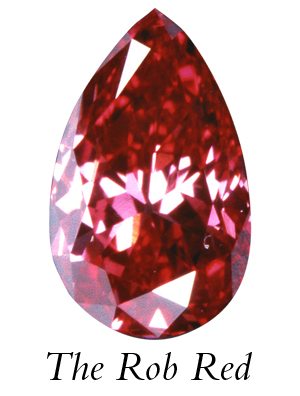Is a red diamond red when it comes out of the ground? Is it red when it comes off the polishing wheel? Or is it red when it’s seen under a particular light source? The answer is: yes, yes and yes. But in the current marketplace, where Gemological Institute of America (GIA)certification is the “must-have” document, a diamond is officially red only when it is certified by the GIA to be “fancy red.”
Rarest of Rare
 Reds — pure, natural red diamonds with no modifying colors — are the rarest of the rare within the world of fancy color diamonds. The few that have successfully traveled the road to certification, been named and gained fame in the diamond world are referred to by their monikers like old friends. Chief among these is the Moussaieff Red. This 5.11-carat, shield-shaped stone was cut by William Goldberg Co. in the 1990s. It is the largest fancy red diamond ever graded by GIA and is believed to be of Brazilian origin.
Reds — pure, natural red diamonds with no modifying colors — are the rarest of the rare within the world of fancy color diamonds. The few that have successfully traveled the road to certification, been named and gained fame in the diamond world are referred to by their monikers like old friends. Chief among these is the Moussaieff Red. This 5.11-carat, shield-shaped stone was cut by William Goldberg Co. in the 1990s. It is the largest fancy red diamond ever graded by GIA and is believed to be of Brazilian origin.
Although the Hancock Red is one of the best-known stones that come up in any discussion of red diamonds, this 0.95-carat stone is not a true red stone, according to the GIA, which graded it “fancy purplish red.” It was sold to a collector named Warren Hancock — hence the name — in 1956, reportedly for $13,500, and subsequently sold at auction in 1987 for $880,000, or $926,000 per carat. Yet, even at that price, purplish red is a long way from “fancy red.” As one dealer put it, “The GIA does not give away grades.” This stone, too, is a Brazilian gem.
Indeed, from the GIA’s beginnings, and for decades into its existence, no stone received a laboratory report that described it simply as “fancy red.” To earn the designation, a stone must display specific characteristics. In addition to hue, which is the essential color of the stone, it must also display sufficient impression of tone and saturation, which is the strength of the color and its purity. According to John King, GIA’s chief quality officer, who came up through the ranks at GIA from his start as a diamond grader in 1978, “The fancy red grade is a specific area in color space that is generally darker in tone, strong in saturation and in the red hue. Determining these qualities is done under a specific light source, in a specific physical setting, by a trained gemologist.”
Clearly, those are subjective qualities, decided by a human being, comparing the diamond being examined to similarly colored diamonds. But how do you quantify darker and more saturated stones? And once again, what is red when it comes to diamonds?
Although GIA lighting and viewing conditions are carefully controlled, the gemologist also brings his or her own color acuity to the mix, which in turn is influenced by his or her years of experience. Due to the rarity of red diamonds — with fewer than 30 known to exist — graders simply don’t have the 20, 30 or 40 years of experience viewing them that would allow them to exercise and refine their color vision. And, unlike white or colorless diamonds, where GIA can maintain master sets, there aren’t enough natural red diamonds to use for comparison. Instead, King says, GIA uses color-treated diamonds, which, he says, “have the same visual characteristics.”
Structural Anomaly
Red diamonds, unlike some other fancy colors, get their color the natural way — if a deformation of the structure can be called “natural.” According to Stephen Hofer, renowned colored diamond expert and author of Collecting and Classifying Coloured Diamonds, “Red diamonds are associated with type Ia — nitrogen-rich — diamonds.
Pressure is applied to these diamonds and it creates a graining that leads to the red color.” Hofer has made color in diamonds his life’s work. He has created his own proprietary system to classify and name color — that most elusive of qualities — in diamonds.
 But even Hofer was surprised when he was asked to view a 0.59-carat diamond believed to have been found in an alluvial deposit in Brazil. The stone was shown to him by Robert Bogel, a gemologist, collector and connoisseur of diamonds. Bogel saw something very special in this pear-shaped diamond, something that he wanted confirmed by the “experts’ expert.” Hofer recalls, “I looked at the stone; I measured it two or three times. Not only was it stronger red than the 0.95-carat Hancock Red, but it was also more toward the pure red line, the line that defined absolute, pure red. The Rob Red diamond, as it became known, is the most saturated and purest red diamond measured visually and instrumentally to date in the world.” To accurately describe its qualities, he says, it deserves the title of “fancy intense red” because it exceeds the purity and saturation of the Hancock Red. Furthermore, it is VS1 clarity.
But even Hofer was surprised when he was asked to view a 0.59-carat diamond believed to have been found in an alluvial deposit in Brazil. The stone was shown to him by Robert Bogel, a gemologist, collector and connoisseur of diamonds. Bogel saw something very special in this pear-shaped diamond, something that he wanted confirmed by the “experts’ expert.” Hofer recalls, “I looked at the stone; I measured it two or three times. Not only was it stronger red than the 0.95-carat Hancock Red, but it was also more toward the pure red line, the line that defined absolute, pure red. The Rob Red diamond, as it became known, is the most saturated and purest red diamond measured visually and instrumentally to date in the world.” To accurately describe its qualities, he says, it deserves the title of “fancy intense red” because it exceeds the purity and saturation of the Hancock Red. Furthermore, it is VS1 clarity.
In any area of nature, pure red is actually a range of colors. “But,” Hofer says, “you cannot compare red in diamonds to other objects that are red. Mother Nature has the recipe of heat and pressure and nitrogen to make a red. You can make a comparison of hue, tone and intensity. If you take a red diamond, as you get darker, you get brownish. When you measure different fancy reds, you take the layer of hue, lightness and saturation; it defines a range of color.”
But in grading reds, unlike, say, pinks, you don’t have a fancy light red or a fancy intense red because you would then be moving across the spectrum into either pink or brown, and then you would pick up modifiers in the grade description. Hofer adds, “Deep pinks get darker and cross over a plane or a threshold where pink starts to look red.”
Reds, when they occur, are usually small in size. Three diamonds recently graded “natural, fancy red” by the GIA for colored diamond specialist Ishay Ben-David weigh in at 0.31 carats, 0.39 carats and 0.40 carats, for a total of 1.10 carats. The three radiant-cut stones are well matched in color and size, and range in clarity from VS1 to SI1. Reds rarely occur any cleaner than that. It is just the nature of the material.
Coaxing Color
Unlike pinks, which depend on the cutter’s skill to coax the maximum color from the rough material, reds come to the cutter as reds. Having said that, there is still a certain degree of magic that can be performed on the polishing wheel, much of it having to do with achieving a darker tone that translates to a redder color. “You cut the stone to make the light bounce multiple times,” explains Hofer. “A radiant cut traps light and the light picks up more color; it is going to look redder.”
The trick, if one may call it that, is to bring out as much of the red that is inherent in the stone without killing its brilliance and beauty, and without sliding down the slippery slope until the essential tone of the stone changes. According to King, “Modifiers are added when the color falls out of the fancy red range. For example, if the stone is considered too dark and beyond what we have specified as the fancy red boundary, it then falls into the fancy brownish red grade range.”
But beauty, as well as color, is also in the eye of the beholder. We do not live under a specific light source used in the GIA lab or on some dealers’ desktops. We live under natural daylight, incandescent light and the dreaded fluorescent light, and our eyes tell us different things. David Shara of Optimum Diamonds says, “Your eyes never change and the diamond never changes, but the light source does.” This is why he says, for example, that stones that have been graded by GIA as “fancy red” may appear to have the brown modifier when viewed in other lights. The grade is correct under the given lighting conditions. At that point, it is up to the potential customer to decide, do I need the certificate or do I want the color that I see, the color that my years of experience tell me should be called “red”?
Article from the Rapaport Magazine - December 2010. To subscribe click here.